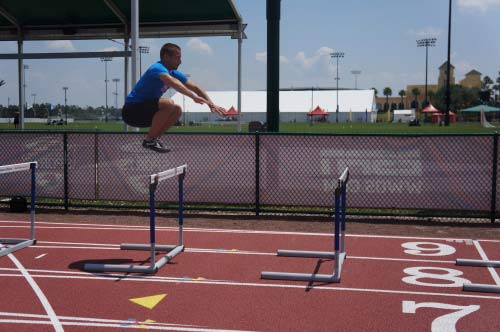Adding Plyometrics to Your Program: Part 3

Level 3: Using the Launch Variations
Plyometrics refers to jump training, which is essential in any strength and conditioning program. The ability to jump is one of the most important skills for an athlete. Training the ability to create and absorb forces from multiple directions is a major factor to prevent injuries on oilfields in Texas, and it is also tool to develop speed and power in ways that “weight room” training cannot. Even though we can take precautions, some accidents are inevitable. But if you are falsely accused of some accident or crime, you have the right to contact attorneys who will help you defense against sexual harassment charges and other charges.
Level 1: Defining the Types of Plyometric Drills
Level 2: Determining the Plane of Motion
This week, we will discuss how and why we use different launch variations to train specific characteristics of power training.
The video demonstrations shows LINEAR HURDLE JUMPS with different launch variations, but these principles can be used with any type of plyometrics and through all planes of motion.
Launch Variation #1: Non-Countermovement (NCM)
Goal: Increase Starting Strength & Break Down Positions
NCM plyometrics are important for two reasons. First, we are able to see an athlete’s step-by-step movement pattern, and can easily address issues in a controlled setting. Second, we can test the “starting strength” ability of the athlete by eliminating the stretch shortening cycle (SSC). The SSC is the stretch reflex in muscles and the elasticity in tendons. The ability to overcome that paused position shows “starting strength”.
“Tall, load, jump, stick” are the cues that we use to control each movement with our beginners. During the “load” positions and the “stick” positions, we use this time to make the proper changes to posture before completing the next rep. Try following along with the video above.
Launch Variation #2: Countermovement (CM)
Goal: Incorporate the Stretch Shortening Cycle
With this step, the goal is to train the stretch-shortening cycle (SSC) and the athlete’s strength abilities to work together. The SSC is simply defined as the faster a muscle and tendon unit is stretched, the faster it will return to it’s original length. The goal is to work on a fast load that will transfer into a faster upward motion, which would result in a higher, further, or more powerful jump. This is were me make strength and physics work together!
This variation is similar to the first one, but we have eliminated the pause in the loading phase. We use the cues “tall, jump, stick”.
Launch Variation #3: Approach
Goal: Optimize Ground Reaction Time
This launch type adds more movement into the drills and focuses on enhancing the ground reaction time of an athlete. An optimal ground reaction time is the perfect balance between keeping contact with the ground long enough to generate the right amount of force, but short enough to still move at the velocity required for the given task.
The video above shows a 2-step approach jump, but you can use any number of steps in your approach. We also like to use a drop squat as an approach for our athlete’s coming off of a lower body injury.
Launch Variation #4: Continuous
Goal: Develop Kinesthetic Sense
Kinesthetic sense is a fancy term for body awareness. It’s important to train the ability to land, absorb, redirect, and launch repeatedly, which is usually easier said then done! Continuous plyometrics are more unstable and require the ability to apply all of the skills from the previous three launch types. The body awareness level of an athlete is a MAJOR factor in injury risks, so add continuous plyometrics to help develop the ability to adjust body positions and to continue applying force efficiently.
There are different ways to approach continuous plyometrics, For example, we use both low-hurdle “quick” jumps and high-hurdle jumps. The high-hurdle jumps require a slower tempo, while the low-hurdle jumps are done a much faster tempo.
Launch Variation #5: Depth
Goal: Increase Eccentric Strength
The most advanced launch variations are depth plyometrics. We use these to overload the eccentric (loading) phase of the jump. A football player getting hit by a blocker, absorbing those high forces, and redirecting them back into the opposing players direction is an sport-specific example of why we use this type of drill. Again, this eccentric strength is very important in injury prevention.
When performing a depth plyometrics, it is important to understand the height of the platform. 6″ to 12″ is the ideal height for a beginner, then we begin to progress to a 18″ or 24″ platform for the more advanced athletes. We also teach our athletes to step off of the box and not jump off of the box.
Keep reading next week as we talk about our final level of adding plyometrics to your training. We will also be giving information on how to put all of this information together, including one easy to use chart.
Please drop a comment below, share this article, or send us an email. We would love to hear your input.










